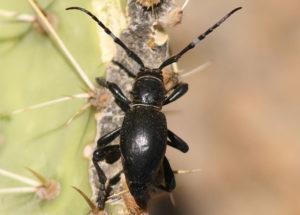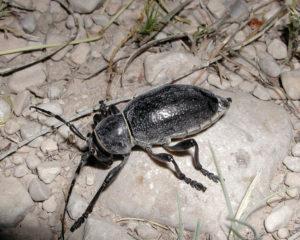The cactus longhorn beetles are a genus belonging to the family of longhorn beetles. These beetles are found in North American deserts, with both the adults and the larvae feeding on cacti.
The most well known species of this genus is Moneilema gigas, which is a flightless, black beetle found in the Sonoran desert.
Size: 0.51-1.46 in (1.3-3.7 cm)
Color: They are mostly black, with mottled white elytra.
Other Characteristic Features: These beetles are incapable of flight, with their elytra fusing into a single, hardened shell. Their head is elongated, almost horse-like.
The larvae have brown heads and can be found incol3 the stem or roots of their host plants.
Pupation occurs incol3 the cactus they fed on as a larva, overwintering during this period.
The eggs are laid in different parts of the cactus by the female beetle.
| Lifespan | 1-2 year |
| Distribution | Western United States and northern Mexico |
| Habitat | Arid and semi-arid regions such as deserts |
| Predators | Lizards, skunks, and wood rats |
| Seasons active | May-September |
| Host Plants | Cacti, mainly prickly pear and cholla |
| Diet of adults | Flowers, fruits, and foliage of cacti |

The larva bore into cacti, causing damage to their roots and stems. While burrowing in, they secrete a green substance that hardens and turns black. This substance damages the cactus, softening its tissue.

Image Source: content.eol.org,live.staticflickr.com, i.pinimg.com, angelfire.com, a4.pbase.com, wixmp.com
The cactus longhorn beetles are a genus belonging to the family of longhorn beetles. These beetles are found in North American deserts, with both the adults and the larvae feeding on cacti.
The most well known species of this genus is Moneilema gigas, which is a flightless, black beetle found in the Sonoran desert.
Size: 0.51-1.46 in (1.3-3.7 cm)
Color: They are mostly black, with mottled white elytra.
Other Characteristic Features: These beetles are incapable of flight, with their elytra fusing into a single, hardened shell. Their head is elongated, almost horse-like.
The larvae have brown heads and can be found incol3 the stem or roots of their host plants.
Pupation occurs incol3 the cactus they fed on as a larva, overwintering during this period.
The eggs are laid in different parts of the cactus by the female beetle.
| Lifespan | 1-2 year |
| Distribution | Western United States and northern Mexico |
| Habitat | Arid and semi-arid regions such as deserts |
| Predators | Lizards, skunks, and wood rats |
| Seasons active | May-September |
| Host Plants | Cacti, mainly prickly pear and cholla |
| Diet of adults | Flowers, fruits, and foliage of cacti |

The larva bore into cacti, causing damage to their roots and stems. While burrowing in, they secrete a green substance that hardens and turns black. This substance damages the cactus, softening its tissue.

Image Source: content.eol.org,live.staticflickr.com, i.pinimg.com, angelfire.com, a4.pbase.com, wixmp.com